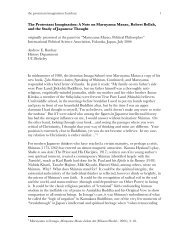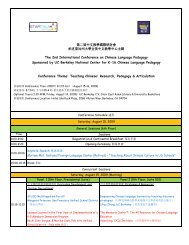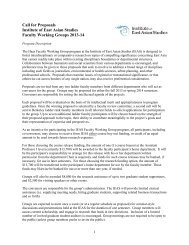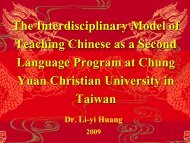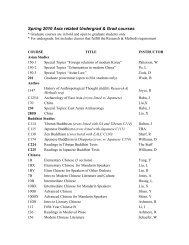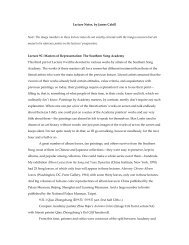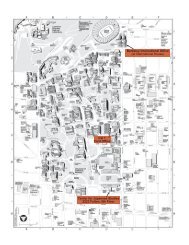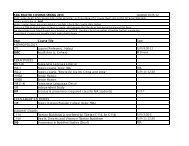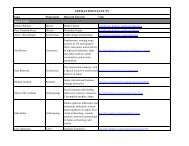Third Edition Spring 2013 - Institute of East Asian Studies, UC ...
Third Edition Spring 2013 - Institute of East Asian Studies, UC ...
Third Edition Spring 2013 - Institute of East Asian Studies, UC ...
Create successful ePaper yourself
Turn your PDF publications into a flip-book with our unique Google optimized e-Paper software.
stance, there are constant controversies amongst different ethniccommunities related to what the ethnic Chinese see as educationaldiscrimination.In Malaysia, there are basically two types <strong>of</strong> public elementaryschools. One is the Malay-medium national schools whereMalay (Bahasa Melayu) and English are the recognized languages<strong>of</strong> instruction. 21 The other type is the national-type schools whereethnic languages such as Chinese and Tamil are taught, while Malayand English courses remain compulsory. 22 Although ethnicChinese enjoy the freedom to send their children to either type <strong>of</strong>school at the primary level, students have few options but to attendMalay-medium high schools so that they can further their studiesat the country’s public universities. 23 Otherwise, they may chooseto attend private Chinese-medium schools outside <strong>of</strong> the publiceducation system, though the graduates <strong>of</strong> these schools can onlygo abroad for higher education and have absolutely no chance <strong>of</strong>enrolling in domestic public universities. Such education policiesresult from the 1956 Razak Report, in which the Malaysian governmentestablished the goal <strong>of</strong> making Malay the dominant medium<strong>of</strong> instruction by assimilating Chinese and English national-typeschools into the Malay-medium national school system. 24 Throughvarious types <strong>of</strong> political campaigns and fund raising projects, theMalaysian Chinese have exerted every effort to protect their owneducation system. To this day, however, the government does notrecognize the Chinese-medium independent schools. Due to thefavorable treatment <strong>of</strong> bumiputera, it is also far more difficult forChinese and Indian students who attend Malay-medium nationalschools to get in to public universities, not to mention the paucity<strong>of</strong> financial aid available to non-bumiputera students.One <strong>of</strong> the consequences <strong>of</strong> such education policies is atrend among ethnic Chinese students to study abroad. Traditionally,Singapore and Taiwan have been two major destinations for Ma-21 Sekolah Kebangsaan.22 Sekolah Jenis Kebangsaan23 Chow Kum Hor, Battle to save Malaysia’s Chinese dropouts, Asia One, TheStraits Times, 31 Jan 2008 http://www.asiaone.com/News/Education/Story/A1Story20080130-47357.html(Accessed 11/29/2012)24 ibid.laysian students <strong>of</strong> Chinese background, not only because <strong>of</strong> theirgeographical proximity and their close linguistic and ethno-racialties with the ethnic Chinese in Malaysia, but also due to their ownrespective policies <strong>of</strong> attracting ethnic Chinese students from overseas.25 Boosted by the rapid development <strong>of</strong> the China-Malaysia bilateralrelationship in recent years, however, there is an increasingnumber <strong>of</strong> Malaysian Chinese students who choose to study in China,owing to the fact that China has a wider range <strong>of</strong> schools at arelatively lower cost. As <strong>of</strong> 2011, there were approximately 4,000Malaysian students studying in China. 26 Unsurprisingly, these studentsare predominantly self-financed ethnic Chinese, althoughthe exact number is unknown.In the name <strong>of</strong> continuously promoting the development <strong>of</strong>the bilateral relationship, in 2007 the Ministry <strong>of</strong> Education <strong>of</strong> Malaysia(KPM) launched a government scholarship program to trainMalaysian Mandarin teachers. Selecting students from nationalhigh schools across the country, the KPM has since sent out fivebatches <strong>of</strong> students to Beijing Foreign <strong>Studies</strong> University (BFSU)to pursue bachelor degrees in teaching Mandarin as a second language.27 Following the KPM program, the Majlis Amanah Rakyat(MARA), a government-run bumiputera development agency, hasalso signed an agreement with BFSU to train Mandarin teachers. As<strong>of</strong> 2012, there have been 175 Malaysian students studying at BFSUthrough these two programs. Like many other government educationprograms in Malaysia, the recipients <strong>of</strong> these two scholarshipsare predominantly Malay. According to an unpublished documentfrom BFSU, out <strong>of</strong> the 175 students, there are only two ethnic Chinese,one ethnic Indian, and three indigenous Kadazans. 28In addition to helping Malaysia train its non-ethnic Chinese25 Lim Mun Fah, More expensive to study in China than Taiwan, SinchewDaily, 22 July 2010, http://news.asiaone.com/News/Education/Story/A1Story20100722-228336.html(accessed 12/03/2012)26 Premier Wen Jiabao’s speech at the Malaysia-China Economic, Trade, andInvestment Cooperation Forum in Kuala Lumpur, Malaysia on 28 April 2011.27 Program Pendidikan Ijazah Bahasa Mandarin, Zhao Wanzhen, “Speech at theOpening Ceremony <strong>of</strong> the 2012 Malaysian Mandarin Teacher Training Program at BFSU”(unpublished document), September 2012.28 Beijing Foreign <strong>Studies</strong> University, “2012 nian 9 yue yingjie malaixiya jiaoyubu”(Welcoming the KPM Delegation in September 2012), (unpublished document), September201217 Kankan Xie Ethnicity And China-Malaysia Relations 18




